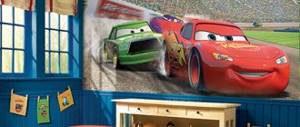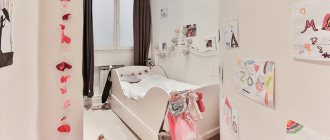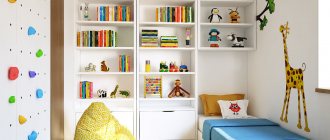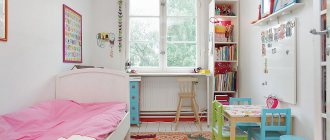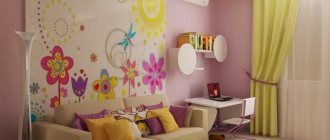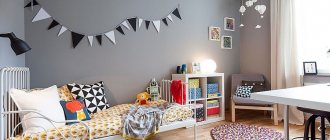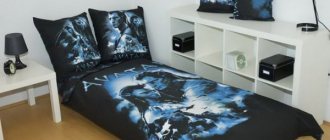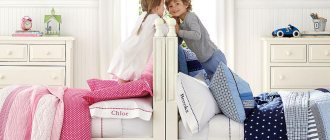The child spends all his free time in the children's room. Plays, sleeps, studies, etc.
It is very important to create comfortable conditions for him. Of course, during the day natural light illuminates the room, but with the onset of darkness you need to think about artificial light.
After all, light affects a child’s vision and his peace of mind. Very bright colors hurt your eyes, and dim ones strain your eyesight.
Natural lighting - its function
No one can argue that light from the sun during the day is the best option. Select a room where there is more light. As a rule, this is the eastern side.
In the morning, the child should wake up from the rays of the sun, so he gains vigor for the whole next day.
If there is still not enough natural light in the children's room, there is a way out. Hang curtains in a bright shade with airy fabric.
For example, blue or yellow, it all depends on the design of the room.
THE RIGHT LIGHT FOR A CHILDREN'S ROOM
Even during play, the children's room should be sufficiently lit. Otherwise, your eyes quickly get tired and start to hurt. A single ceiling light may provide enough light for a room, but it does not create a cozy atmosphere.
The best solution is several light sources that are distributed throughout the children's room and shine less intensely. If you place lights at different heights and angles, light and shadow overlap each other, sharp contrasts blur, and the room looks cozier.
Shining light everywhere
If the children's room is small, then wall and ceiling lamps are suitable, which indirectly and harmoniously diffuse the light. To illuminate a large children's room well, we also recommend using rope, rod or track systems. It's best to check whether the lights in the play area are blinding to your child. In addition, bright light casts sharply defined shadows - the eyes must strain very hard to compensate for the difference in brightness.
Light directed upward reflects off the ceiling of the room, making the room appear larger and wider. The light shining down reveals the playpen, the child plays in the spotlight. Light from the sides emphasizes contours and textures. If several spotlights shine in different directions, the children's room almost looks like it is in sunlight.
A ceiling light is usually not sufficient and additional light sources must be available.
LIGHT FOR REST AND SLEEP
In a children's bedroom, a lamp is almost indispensable. If it is located directly next to the bed, children can independently turn it on and off with one movement of the hand. Securely mounted wall lights are also suitable. It's important to make sure the light is dim because reading requires a different brightness than falling asleep. If children sleep in bunk beds or loft beds, an additional light switch on the bed can also help turn off a wall or ceiling light. To do this, the kids don’t even need to sit down - just stretch out your hand: there are switches.
When siblings have to share a room, conflicts over light are more likely to arise. While one wants to sleep, the other is still reading his book. Then the so-called "Night Reader" (an ultra-thin plate with LEDs) can help in such situations. In the dark, the reading lamp is simply placed on the page of the book and illuminates it completely without glare, the room remains dark and the other child can sleep peacefully. However, this type of lighting is only suitable for short periods of time because it tires the eyes. Interesting article: FLOORING FOR A CHILDREN'S ROOM
A lamp next to the bed helps you fall asleep and can be turned on or off by your child at any time.
NIGHT LAMPS IN SOCKET
The lights turn off, but not completely, since many children are afraid of the dark in preschool age. This fear often lasts for years, but is easily dispelled when the soft night light allows one to fall asleep. Energy-saving night lamps turn on automatically when it gets dark and go off when it gets light.
REGULAR SAFETY CHECKS OF LUMINAIRES
All lamps in the children's room should be checked regularly. On rope and rod systems, check regularly that all connections are secure and tight. In the worst case, a fire may occur.
Experts advise using protective transformers. Anyone installing halogen lamps must strictly maintain the prescribed distances from flammable materials. And if you're already installing: don't forget about the smoke detector in the children's room.
Types of lighting fixtures
It seems like an ordinary lamp, but the choice is not so simple, each has its own characteristics that must be studied:
- Power - light should be moderate;
- Safety - the lampshade should not heat up and be easily removed;
- Control - it is better to give preference to lamps with a control lever;
- Lamp design;
- Practicality during operation.
Let's take a closer look at the lamps for the children's room.
Let's start with something simple - the lampshade, what should it be? Lampshades made of paper or fabric have always been practical and safe. For those who like glassier ones, we advise you to choose frosted glass models to avoid glare.
Size - give preference to small lamps, without unnecessary tinsel. With flat shape for better light distribution.
Power for proper lighting: per 1 square meter 15 watts, for play and work areas maximum 60 watts.
Types of lamps and lighting devices
Fluorescent lamps lead to rapid fatigue and irritation of the child, and their spectrum is difficult to perceive by vision, so they are not recommended for installation in children's rooms. Experts recommend using halogen and low-power LED lamps as “children’s” light sources.
Light from halogen sources is considered the most perfect, because... it is as close as possible to the solar spectrum. The lamps provide bright, even light and do not dazzle the eyes, reducing fatigue and increasing performance. In addition, the power, service life and energy efficiency of halogen lamps are several times higher than fluorescent lamps.
LED lamps can provide high-quality light to all areas of the nursery with maximum energy savings. LEDs provide soft and uniform light, close to daylight. Such devices are durable and safe. In addition, having a wide color range, they allow you to create fabulous and amazing lighting effects.
LED effects in the nursery
Lighting options in various functional areas of a children's room The number of lamps depends on the size of the room, the number of its functional zones, as well as on the power of the light sources. The child’s personal space should be divided into several zones, each of which requires its own special lighting.
- game Zone;
- work zone;
- sitting area and bedroom;
- a place to chat with friends - for a teenager's room.
The ideal option for artificial lighting for a nursery is multi-level light, which can be obtained using the following options:
- the light of ceiling chandeliers, pendant or spotlights that distribute the main light over the playing area located away from the window;
- local (local) light - wall sconces installed in the recreation area, as well as night lights located above the bed;
- special lighting – table lamp, flexible lamp, work area lighting.
Multi-level lighting for a children's room
General lighting is the main artificial light, which should illuminate not only the play area, but also complement the radiation of the table lamp in the child’s “office”. Main lighting devices should provide bright diffused light, so chandelier shades should be made of frosted glass, paper or plastic. Reflective lamps - transparent glass, mirror and crystal chandeliers give glare and are dangerous for children, especially if the child is a future athlete. In modern children's lighting, designers use combined light from chandeliers and spotlights, and sometimes LED lighting, which is placed around the perimeter of the room.
